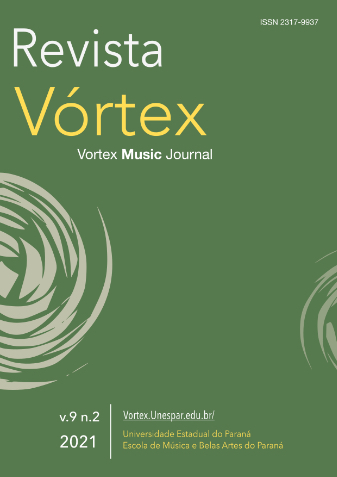Dead voices and lost sounds: an imagined sonic history
DOI:
https://doi.org/10.33871/23179937.2021.9.2.10Palabras clave:
sound art, installation, performance, participation, theater for all ages, theater, historyResumen
A project description of a sound art installation and interactive performance presented as part of the Up Close Festival in New York City in the winter of 2019/2020. The article is authored by the creator and director of the piece, Adrienne Kapstein. Created for an all-age audience, the piece was a unique, relational and socially engaged experience that merged sound art, live performance, illusion, technology, and audience participation. Designed to be completed in partnership with members of the community it sought to serve, the piece invited participation from every audience member through multiple and varied means of engagement.
Link: https://youtube.com/playlist?list=PLXdYuKtwUhUrirWQ0B2X7XhfrBCGJVlGn
Descargas
Citas
BALL, Joyelle Klaer. Crises of Site: Non-specificity in the Theater. Dissertation for PhD in Theater Studies. University of California, Santa Barbara. ProQuest Dissertations Publishing, 2018.
BISHOP, Claire. Participation. London: Whitechapel Gallery; Cambridge, Mass.: The MIT Press, 2006.
BOURRIAUD, Nicolas. Relational Aesthetics. Translated by Simon Pleasance and Fronza Woods. Les Presse Du Réel, 2002.
DIMEO, Nate, These Words Forever. Podcast The Memory Palace, Episode 12. Available at: https://thememorypalace.us/2009/06/episode-12-these-words-forever. Accessed: 01 Dec. 2021. Radiotopia, 2009.
ECKERT, Stephen. What is Immersive Theatre? Contemporary Performance, November 9, 2021. Available at: https://contemporaryperformance.com/2021/11/09/immersive-theater/. Accessed: 01 Dec. 2021.
GERTNER, Jon. The Idea Factory: Bell Labs and the Great Age of American Innovation. Penguin Books, 2012.
HILL, Sharon. Spooky Rocks. Skeptical Inquirer, Volume 27:3, January, 2017. Available at: https://skepticalinquirer.org/newsletter/spooky-rocks/. Accessed: 01 Dec. 2021.
KAPSTEIN, Adrienne; GOLDSTEIN, Thalia. Developing wonder: Teaching theatre for the very young through collaboration with developmental psychology. Youth Theatre Journal, 16 April 2019.
MACHON, Josephine. Immersive Theaters: Intimacy and Immediacy in Contemporary Performance. Basingstoke: Palgrave Macmillan, 2013.
MUIR, John, referenced at https://welikia.org/, WCS, 2008-2017.
MUSANTE, Peter. Up Close Festival 2019 Maker"™s Guide for commissioned artists. December 2018, with revisions September, 2019 (not published).
O"™TOOLE, John. Theatre in Education, New objectives for theatre - new techniques in education. Kent: Hodder and Stoughton, 1976.
PEARSON, Mike, SHANKS, Michael. Theatre/Archaeology. Routledge, 2001.
SHMIDT-CHAPMAN, Jonathan, Artistic Director; Trusty Sidekick Theater Company (2011-2016). Press Release for Up and Away, BroadwayWorld JR, Sept. 29, 2015. Available at: Broadwayworld.com
SHMIDT-CHAPMAN, Jonathan. Take a Closer Look, Inside the Up Close Festival of Immersive Theatre for Young Audiences. TYA/USA, Nov. 17, 2019. Available at: https://www.tyausa.org/tya-today/take-a-closer-look/. Accessed: 01 Dec. 2021.
VILLIERS DE I"™ISLE-ADAM, Auguste. Future Eve. Tradition Classics, November 23, 2012.
WALMSLEY, Ben, Co-Creating theatre: authentic engagement or inter-legitimation? Cultural Trends, Vol. 22, No. 2, p. 108–118. DOI: 10.1080/09548963.2013.783176
WESTERKAMP, Hildegard (interview). Ear Room by Mark Peter Wright. July 6, 2011. Available at: https://earroom.wordpress.com/2011/07/06/hildegard-westerkamp/. Accessed: 01 Dec. 2021.
WESTERKAMP, Hildegard. The Disruptive Nature of Listening. Keynote Address, at International Symposium on Electronic Art, Vancouver, B.C. Canada August 18, 2015. Available at: https://www.hildegardwesterkamp.ca/writings/writingsby/?post_ id=11&title=the-disruptive-nature-of-listening#:~:text=By%20its%20very%20nature%20 listening,is%20disruptive%20in%20its%20nature
Publicado
Cómo citar
Número
Sección
Licencia
Derechos de autor 2021 Adrienne Kapstein

Esta obra está bajo una licencia internacional Creative Commons Atribución 4.0.
Los autores conservan los derechos de autor y conceden a la revista el derecho de primera publicación, con el trabajo simultáneamente bajo la licencia Creative Commons Attribution Licence que permite compartir el trabajo con reconocimiento de autoría y publicación inicial en esta revista.






